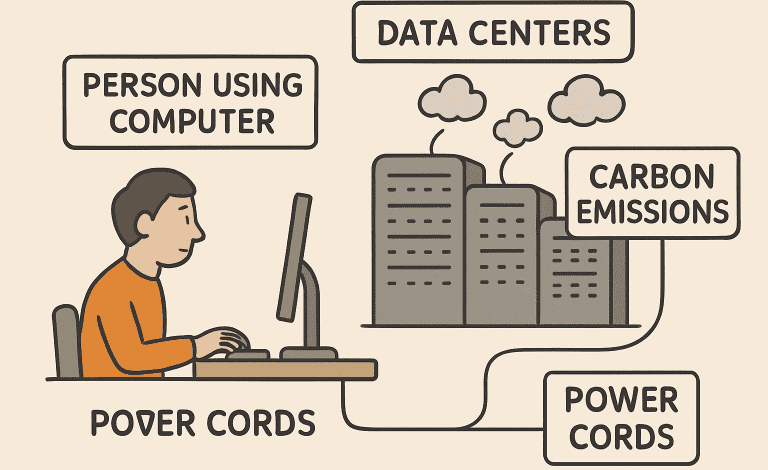How Your Browsing Habits Shape the Planet

Every day, our digital lives leave behind invisible environmental traces. As the internet powers global communication and convenience, each action online—from casual searches to hours of video streaming—demands a surprising amount of energy. Few realize how routine activities can add up, not just in terms of personal convenience, but also in terms of the cost to the climate. According to GreenMatters on Shift browser even the choice of browser and how sites are designed can impact the planet’s overall carbon footprint.
Rampant growth in cloud computing, social media, and streaming services has made accessing content easier than ever, but this convenience often comes at an environmental cost. As data centers expand to support our curiosity and need for instant information, their energy usage continues to rise. Given the ecological implications of growing digital demand, it’s essential to understand how everyday browsing habits affect the environment and what can be done to minimize their impact.
Data transmission, driven largely by advertising and tracking, increases the load on infrastructure and adds to emissions. The cumulative effect—a footprint as significant as that of some heavy industries—should encourage internet users to become more conscious of their choices. Understanding where these emissions originate is a crucial step toward reducing your online impact.
Learning about the mechanics behind digital carbon emissions and the factors influencing our online behavior opens a pathway to change. By acknowledging the intersection of technology use, energy consumption, and individual actions, we can all contribute to a cleaner, greener digital world.
The Hidden Carbon Footprint of Internet Usage
Few people realize that every online transaction—be it searching Google, sharing photos, or reading the news—relies on massive data centers operating worldwide. These facilities require constant cooling, vast server banks, and non-stop electricity, often supplied by fossil fuels. In fact, researchers have found that the combined emissions from data centers rival those of major industrial sectors. What makes the picture even more complex is the additional impact of targeted advertising, tracking, and the constant exchange of user data.
Data Centers and Electricity Demand
A single data center can consume as much electricity as a small town. Globally, these centers account for nearly 1% of the world’s total electricity demand, with trends indicating that this figure could soon rise even higher as streaming, remote work, and AI-driven applications continue to proliferate. According to The New York Times, some of the largest tech companies are investing heavily in renewable energy, but fossil fuels remain integral to digital infrastructure for now.
Streaming Services and Energy Consumption
Digital entertainment, especially streaming video and music, has experienced explosive growth. Platforms like Netflix and YouTube deliver content on demand, requiring significant server resources and data transfer. A popular music video, such as “Despacito,” with billions of views, can utilize as much electricity as several countries do over an entire year. High-definition formats, particularly 4K and HDR streaming, significantly increase energy consumption compared to standard-definition formats.
Research published in National Geographic highlights that watching an hour of streaming video on a mobile device is less energy-intensive than watching the same amount on a large television. Still, every device type contributes to aggregate demand.
The Role of Web Tracking in Carbon Emissions
Modern websites often load dozens of third-party scripts, mainly to track users for targeted ads and analytics. This tracking increases both page load times and data usage. A major study found that these extras can increase data transmission by over 21%, resulting in approximately 11 million tonnes of greenhouse gas emissions every year. These emissions are comparable to those of some food and cryptocurrency production sectors, highlighting the significant impact of invisible code on everyday carbon footprints.
Implications for Privacy and the Planet
Besides the privacy concerns associated with tracking, the environmental cost is often overlooked. Utilizing privacy-focused tools and browsers that block trackers doesn’t just safeguard your data—it also directly reduces the volume of energy required to support daily browsing.
Digital Platforms and Human Curiosity
The way we interact with the internet is shaped by social factors as much as technology. Studies indicate that users in countries with greater gender and educational equality explore a broader range of web topics. At the same time, those in less equal regions tend to remain more focused in their browsing habits. This diversity in curiosity indirectly affects the amount of data consumed and the resulting energy usage, as more varied browsing patterns often require accessing a wider range of servers and generating more data exchanges.
Influence of Societal Structures
The design and recommendation features of digital platforms also guide user curiosity. Algorithms optimize for engagement, sometimes steering users toward viral content that may increase demand for resource-intensive services, such as video streaming or real-time interaction platforms.
Practical Steps to Reduce Your Digital Carbon Footprint
- Optimize Streaming Settings: Use standard definition when high definition isn’t necessary, and download content for offline viewing to limit repeated data transmission.
- Limit Storage: Regularly delete old emails and unnecessary cloud files to reduce data center loads.
- Choose Efficient Devices: Opt for energy-saving computers and power them down completely when idle, rather than relying solely on sleep mode.
- Utilize Tracker Blockers: Use browser tools to reduce data-heavy tracking requests and minimize privacy risks.
- Support Sustainable Platforms: Opt-in to tech services that invest in renewable energy or demonstrate carbon offsetting efforts whenever possible.
Conclusion
As the digital world expands, so do the implications for our planet. Recognizing the energy consumption hidden behind every online action is the first step in fostering a more responsible and sustainable internet future. Small shifts in browsing behaviors, mindful device use, and advocating for greener technology can meaningfully reduce your digital carbon footprint and drive industry-wide change—moving us closer to a healthier planet for future generations.



